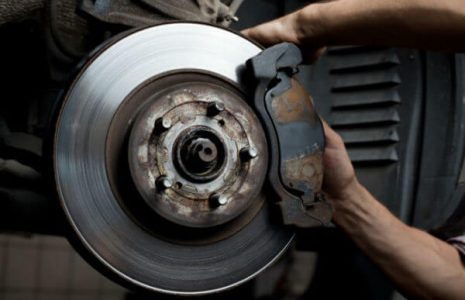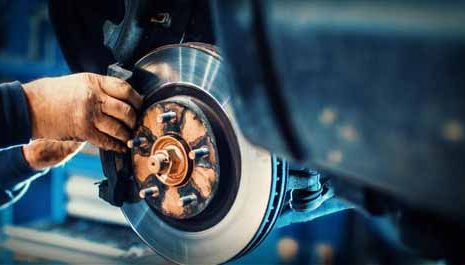Braking Power of the brake Pads and brake discs
about brake padGenerally, most automobile companies use similar materials in the manufacture of brake pads. The Brake Pads are mainly made up of fibers, filers, friction modifiers and resin binders. But the type of material used to determine the braking power and the percentage of their use in each section is a secret for different companies.
The fibers are a part of the brake pad that provides the strength of the brake pad. Non-asbestos fibers composed of organic materials (NAO) are materials used in the manufacture of natural and artificial fibers used in brake pads.

Filers are materials used to increase the strength of the brake pads against corrosion and wear. These materials may come from a wide range of natural and mineral materials. Metals Powders, Oxide Powders of most Metals and Ceramic Powders are among the items that are used to increase the wear resistance of brake pads at high temperatures without losing their frictional features.
Aluminum, zinc, metal sulfate and graphite are materials that are used as modifiers.
The resins binders have a vital role in the brake pad structure. Brake pad material will be separated and disintegrated if the resin is used at high pressure and high braking temperatures. Therefore, the resins must be of good quality so that brake pads contact properly. The use of organic resins with excellent properties is one of the factors behind the brake pads’ price increase.
This is worth noting that the driving behavior of each driver is very effective in determining the type of brake pads and its length of life.
Organic non-asbestos pads (NAO)
In the construction of non-asbestos brake pads, artificial glass fibers, aramid fibers (fibers that are replaced by asbestos and are widely used in space and military industries) and organic (organic) fibers are used. These materials are used to strengthen the brake pads’ materials and are added to the brake pads’ fiber structure as organic or non-organic modifying materials. The brake pad modifier materials are actually added to increase the braking power of the brake pad.
Organic brake pads are used in many modern vehicles and are silent due to their soft structure. This kind of pad is also used in industrial machinery, which is the main reason for this choice. But these pads are less durable due to their softness and high rigidity compared to their semi metallic and metallic brake pads, especially when working at very high temperatures.
No doubt that one of the reasons for their shorter lifetime is the relatively poor heat transfer, which causes their heat to rise and shorten their life. This type of brake pad is a good choice for cars that are commonly used at intermediate temperatures, because of their excellent power of braking, very little sound, and low dust on the rings. But for vehicles that drive through traffic in urban areas, such as taxis, police cars and light truck cars, they are not the right choice.
One way to know if your car uses NAO and standard brake pads is to check the brake pad with a magnet, if the brake pad does not react to the magnet, that means there’s no Iron particles in the brake pad. This test is in most cases useful.
Ceramic Brake Pads
Having quiet brake pads is one of the ideals of our vehicle. Since the new braking system design is moving towards the shrinking of the clipper and pads, the materials used in the manufacture of pads should also be more effective in reducing the noise caused by braking. For this reason, the brake pad companies are using fibers, ceramic powders and artificial organic materials in producing brake pads. Ceramic brake pads are made up of ceramic materials and organic materials, and they are considered as a model of NAO pads, but you can also find copper and rice particles in them.
Some manufacturers call this type ceramic brake pads, but the amount of ceramics used in these brake pads is very low; about 1%. So their price is lower than the actual price of ceramic pads. In fact, not all ceramic pads are the same, if the ceramic used is too much, the sound produced during braking with these pads will be excessive, and if the amount of ceramics is low, braking power is not as it is expected.
Semi metallic Brake Pads
The most common type of brake pads are semi-metallic pads. In fact, about 60% of today’s cars use semi-metallic pads. This kind of pad is called semi-metallic pads due to the use of metal elements in their material structure. More than half of the weight of these pads is iron and steel particles, as well as high-density graphite materials that have been used in conjunction with petroleum coke.
Due to the presence of metal particles, this type of pads transmits heat to the disk properly, thus they are cooler than organic pads. The result of this type of design is the good braking power at high temperatures. This cooling of system also prolongs the life of this type of pads.
Low metallic Brake Pads
About 20% of the pads’ weight in low metal brake pads is made up of metals such as iron and steel, and most of it is made up of fibers and organic and non-organic materials used in the NAO pads. In these pads, composite lubricants are used instead of graphite and are often used in luxury European cars. These pads have a good braking power, but they produce a lot of noise and dust. However, as these cars are properly sealed, no voice can be heard!
Sintered Brake Pads
In manufacturing this type of pads, stainless steel and composite fibers are used and are more suitable for off road, racing and airplanes. When used on normal vehicles, it dramatically loses braking power and takes more meters to stop.
These pads must be warmed up and reach the required temperature in order to have the desired function. Unfortunately, these kind of pads rub disc brakes and reduce the life of the disc several times, however, for a racing car, the longevity of the pad is limited to the end of each race.



